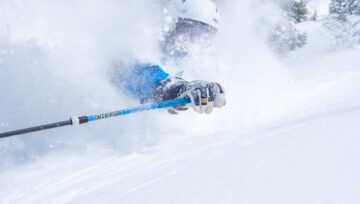Beacon Interference
As skiers pack on more cameras, cell phones and other communication devices for a day in the backcountry, electronic interference with avalanche transceivers has become a pertinent safety issue.
A searching beacon follows a flux line created by the transmitting beacon’s electromagnetic signal and measures the distance of the signal, allowing searchers to pinpoint the transmitting device. When confronted with interference from, say, a cell phone, searching beacons will display erratic and potentially incorrect distance readings and directions, rendering them less reliable and efficient.
New research conducted by John Barkhausen of Prescott College and Alaska Pacific University is one of the first studies to attempt to quantify electrical interference from a variety of common gadgets, such as GPS units, iPods, digital cameras and cell phones. The results, presented at the 2012 International Snow Science Workshop in Anchorage, Alaska, this past summer, supported two conclusions: There is no noticeable effect on a transmitting beacon signal from common, powered-on electronics, and when held near a searching beacon, electronics do negatively affect the beacon’s ability to follow a signal.
The work showed, however, that only electronics in close proximity affect the beacon. “The study pointed out that over 40 centimeters away, electrical interference is minimal. So, it is not exactly much ado about nothing, but it is an easy fix,” said Don Sharaf, co-owner and instructor at the American Avalanche Institute in Victor, Idaho. “The bottom line is, that in most search situations, you can make that 40 centimeter distance happen easily.”
Sharaf added, “What we tell our students is that it is good to have a cell phone on you, so you can make a call for help. You can always stuff it in a back pocket afterwards; you don’t want to take the time to power it down.”
Bruce Edgerly, co-founder of Backcountry Access, said that BCA’s testing with beacons concurs with the study, and everyday cameras and phones are not a big problem. Yet users should still be aware of the potential for serious interference in search mode.
“Just make sure when you’re searching that your beacon is at least 16 inches away from any gadget,” Edgerly said. “Good search technique itself should prevent interference. Your arm should be out, holding the beacon out in front of you; it shouldn’t be held by your face, or your chest.”
There is one notable exception so far, according to Edgerly. “Snowmobile spark plugs crush most beacons,” he said. “You want to be away from your snowmobile if you’re doing a search.”
The International Commission on Alpine Rescue (ICAR) is considering a recommendation of 60 centimeters (about 24 inches) of distance for all gadgets, VHF radios, and other digital products, said Sharaf of the AAI.
Research has not shown that any particular brand or model of beacons is more significantly affected by electronics than others. “I would not choose a beacon based on susceptibility to interference,” said Sharaf. “All the new beacons out there are very good right now.”
Source: espn.go.com










Comments